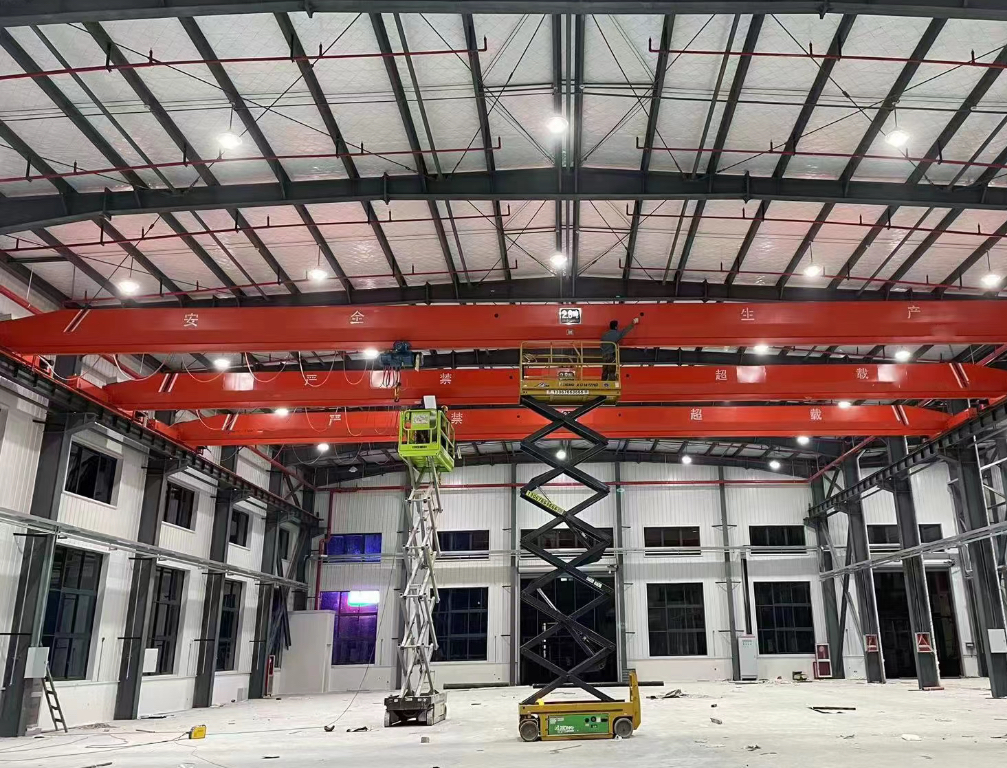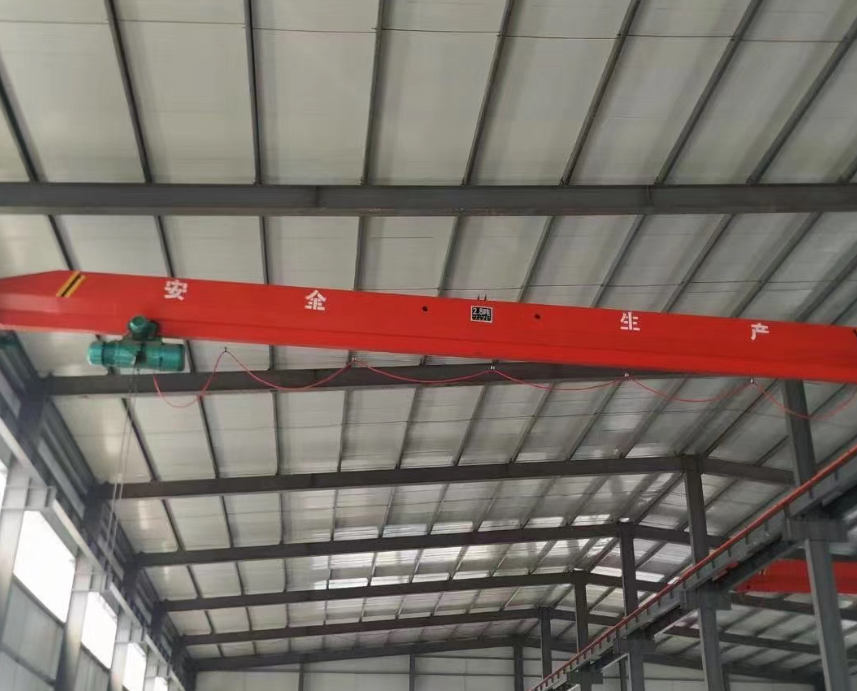Technical parameters and maintenance methods of electric single-beam crane
Safety and technical inspection is the key to the management of lifting equipment. The effect of the use of lifting machinery depends to a large extent on the quality of safety and technical inspection, daily maintenance and management during the use of lifting machinery. Carrying out safety and technical inspection of cranes and timely maintenance and maintenance based on the actual situation of the inspection is of great significance to extending the service life of equipment, improving the integrity and utilization rate of equipment, eliminating potential accidents and ensuring safe production. In order to ensure the safe operation of lifting machinery, it is necessary to establish and improve the maintenance, regular inspection, safety regulations and handover systems for lifting machinery, and educate relevant personnel to implement them conscientiously. The lifting machinery of the unit should be registered, and the specifications, performance and other relevant technical information of each crane should be recorded in detail. At the same time, the technical inspections, overhauls, changes in the important performance of the crane and major accidents of the crane should be recorded for future search and reference.
An important part of crane safety management is to strengthen the safety education of crane operators and urge operators to consciously carry out daily inspections and maintenance of cranes. The daily pre-shift safety inspection of the crane's electromechanical system is within the scope of the operator's responsibilities and cannot be replaced by regular professional inspections of cranes. Only by combining daily inspections with professional inspections can the safe operation of the crane be guaranteed.

1. Inspection of the operating environment
Although the operating environment does not belong to the scope of the crane itself, it is directly related to the safe operation of the crane, so it is also an indispensable content for the safety inspection of the crane. The first inspection is to check whether there are power lines (especially high-voltage lines) in the operating area of the crane. The crane should maintain a sufficient safe distance from them during operation. Otherwise, corresponding measures should be taken to limit the operating range of the crane. Second, check whether the surrounding buildings and temporary facilities will hinder the normal operation of the crane, and whether the crane arm, counterweight and other parts will collide with them, especially when the gantry crane track is extended or the fixed crane is raised and displaced. For automobile cranes, it is also necessary to check whether there are enough outrigger positions, whether there are cavities underground, and the size of the ground bearing capacity. Check the crane track, rail stopper, anti-collision device at both ends of the track, rail gnawing, and track temperature difference gap in detail.
2. Inspection of the traveling part
Mainly inspect the traveling wheel tread, each open gear, coupling, transmission base bolts and traveling wheel axle oil holes. If the surface hardness of the traveling wheel tread is not good, blocky peeling can be seen during the inspection. Each open gear and coupling should be equipped with a protective cover. If the transmission base bolts are loose, they should be tightened in time. Keep the traveling wheel axle oil holes unobstructed.
3. Inspection of metal structures must pay attention to the plastic deformation of metal structures.
The main beam camber is the key part of the crane structure inspection to avoid the disappearance of the upper camber of the crane main beam or even deflection due to factors such as overload and heat radiation. In addition, key inspections should be made to see if the boom is bent or twisted; the ear plates of the root pins of the boom and balance arm, and whether the welds between the web plate of the main beam and the lower cover plate of the bridge crane are cracked. Inspection of the main structural connecting bolts of important parts such as the crane boom, the tower body of the tower crane, the slewing center bearing seat of the gantry crane, and the base of the crawler crane. Since the bolts in the above parts are frequently subjected to the combined effects of tensile stress, shear force and torsion force, if they break from the root, the consequences will be very serious.

4. Inspection of various mechanisms and components
① Brakes are important parts of cranes, which directly affect the accuracy and reliability of the movements of various mechanisms. Therefore, the brakes of the hoisting mechanism and the luffing mechanism should be carefully checked to observe the opening of the brake shoe and the wear of the friction element. For belt brakes, it is necessary to check whether the steel backing of the brake belt has cracks, whether the transmission of the brake is flexible, whether the brake frame is intact, and whether the elasticity of the main spring and auxiliary spring meets the requirements.
② Reducer Check whether the reducer has oil leakage and whether there is abnormal noise in the box during operation. Abnormal noise is generally caused by bearing problems or excessive gear meshing side clearance, severe tooth surface wear and other reasons.
③ Wire rope and pulley Check whether the wire rope has broken wires, wear, kinks and rust. For the positions where the wear and wire breakage are serious but not exceeding the standard, mark them for key re-inspection; check whether the safety limiter of the wire rope in the drum is effective and whether the wire rope pressure plate on the drum is tightened.
The focus of the pulley inspection is whether the wear at the bottom of the groove exceeds the standard and whether there are cracks in the cast iron pulley. The balance wheel of the pitch mechanism pulley group is easy to be overlooked. Before installation, be sure to check its rotation flexibility. If the balance wheel is not flexible, the length and tension of the pitch and lift left and right wire ropes during installation cannot be adjusted by the balance wheel, which will increase the difficulty and operation danger of adjusting the pitch and lift wire ropes at high altitude.
④ Coupling Check whether each coupling is loose or even "rolling key". Pay special attention to check whether the elastic rubber ring of the elastic pin coupling has abnormal wear, and pay special attention to the wear of the gear ring of the toothed coupling. In the case of poor installation accuracy and large offset between the two shafts, the entire gear ring will soon be worn out. If this happens in the lifting mechanism, serious accidents are likely to occur.
5. Inspection of hydraulic system
The lifting, slewing, luffing and outrigger telescopic actions of automobile-type tire cranes generally adopt hydraulic transmission systems. Check whether the telescopic arm hydraulic cylinder can maintain the extended length of the crane arm for a long time, and whether the hydraulic cylinder has leakage; check whether the luffing cylinder and outrigger cylinder have leakage, whether the sinking and retraction amount meet the requirements under the rated load, and whether the outrigger has "soft leg" phenomenon; check whether the operation of each hydraulic pump, valve, and hydraulic lock is normal, whether the action is sensitive and reliable, whether there is abnormal vibration and noise, whether the performance of the seal is good, and whether the hydraulic oil has internal leakage or leakage; check whether the hydraulic oil is deteriorated or contaminated; whether the oil tank liquid level meets the requirements, and whether the high-pressure pipes and joints are leaking.
6. Crane electrical inspection
Crane operates under impact, vibration and swing conditions, and electrical equipment is prone to failure, especially in high temperature, dusty and humid environments, where failures are more likely to cause accidents. Therefore, safety inspections of the crane electrical parts should be taken seriously.
The electrical system must pay attention to whether the insulation resistance of the motor is within the normal range, whether there is any abnormal noise during operation, and whether the temperature rise is normal; when shutting down, check whether the slip rings, brushes, and wire joints have obvious cracks, wear, looseness, and carbon powder attached; check whether the collector and power cable are deformed and worn, whether the tensioning device is normal, and whether the contact between the cable and the slider is good; check whether the outer casing of the electrical components and control system switches is damaged, whether the contact pressure is appropriate when closing the switch, and whether the capacity of the fuse meets the requirements; whether the main contacts and auxiliary contacts of the contactor are burnt, and whether the contactor is properly connected. Check whether the pressure between the contacts is sufficient when touching, whether the contacts are completely disengaged; whether there are any attachments on the suction surfaces of the moving and static iron cores of the contactor, whether there are any abnormal sounds when attracted, whether the arc extinguishing cover is intact; whether the relays on the distribution cabinet are working normally, whether the terminal posts and terminal screws are well fastened, whether the action directions of the controllers in the cab are correct, and whether there is zero-position protection. In particular, check whether there is an emergency power-off switch on the console, and confirm whether the power can be effectively cut off in an emergency; check the sensitivity and reliability of the torque limiter, overload limiter and various travel protection devices.

